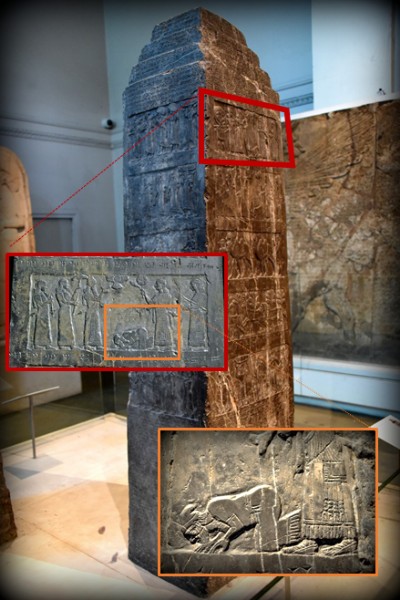It is exceedingly rare to encounter ancient relics which provide a visual glimpse of Israel's past. Such is the case of the obelisk of Assyrian king Shalmaneser III (right), who received tribute from king Jehu in ~841 BC and is depicted while bowing in servitude. This large artifact, housed at the British museum, was discovered by archaeologist Henry Layard in 1846 while excavating in Nimrud, Iraq near the site of the ancient Assyrian capital Kalhu. This could be the only "photo" of a Jewish king!
This black alabaster monument records 31 years of military his victories and includes bas-reliefs of tributes paid by five conquered regions. A caption written in cuneiform over our scene of interest reads: "The tribute of Jehu, son of Omri: I received from him silver, gold, a gold bowl, a gold vase [with pointed bottom?], gold goblets, gold buckets, tin, a royal sceptre [and] spears." Though Jehu was not Omri's son (he was the son of Nimshi), we know it is the biblical Jehu, as Assyrians would refer to successive rulers in relation to the first ruler with whom they had contact. Jehu's name also appears in numerous other Assyrian inscriptions.
Speaking of first mentions, Jehu appears in 1 Kings 19:16 when Elijah sits discouraged in a cave. God tells the prophet to anoint Jehu as Israel's king who would judge wicked king Ahab's house. (God also tells Elijah I have left me seven thousand in Israel, all the knees which have not bowed unto Baal.) We also read of Jehu in 2 Chronicles 22:7-9 and 25:17.
Zealous for the Lord, Jehu began as God promised, as he brake down the image of Baal, and brake down the house of Baal, and made it a draught house (latrine) unto this day. But the damage from king Ahab and his son Joram's unsuccessful wars against now-super power Assyria returned to haunt him, prompting Jehu to align with Assyria in battle against Hazael in Damascus, Syria (2 Kings 8:28). This helps explain why Israel's old ally (now foe) was hostile against Israel; but God records the real reason: Jehu took no heed to walk in the law of the Lord God of Israel with all his heart: for he departed not from the sins of Jeroboam, which made Israel to sin (2Ki 10:31). A sad ending for a king with real potential.

Bas-relief picture ~841 BC, possibly of King Jehu, British Museum of History in London. Photo sources: https://www.bibleodyssey.org/en/tools/image-gallery/b/black-obelisk-kingshipane/, https://historyetc.org/photos/black-obelisk-of-shalmaneser-iii-british-museum/ and https://biblearchaeologyreport.com/2020/10/09/king-jehu-an-archaeological-biography/.
Like this? Consider sharing it to Facebook by clicking the linked icon below.

